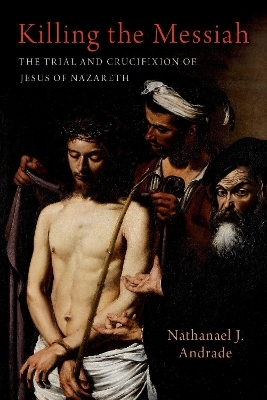
Killing the Messiah
The Trial and Crucifixion of Jesus of Nazareth
Seiten
2025
Oxford University Press Inc (Verlag)
978-0-19-775248-7 (ISBN)
Oxford University Press Inc (Verlag)
978-0-19-775248-7 (ISBN)
- Noch nicht erschienen (ca. April 2025)
- Versandkostenfrei innerhalb Deutschlands
- Auch auf Rechnung
- Verfügbarkeit in der Filiale vor Ort prüfen
- Artikel merken
Killing the Messiah reconstructs the trial of Jesus of Nazareth and the roles played by various people, especially Pontius Pilate, in his crucifixion. It places Jesus' trial in the legal context of Roman Judaea to identify the crime he reportedly committed, why he committed it, and the obligations that authorities fulfilled by having him arrested and tried.
Long ago, on a spring morning in Jerusalem, Pontius Pilate passed judgement on a mysterious preacher. Jesus of Nazareth was nailed to a cross shortly after and died in agony. The effects of this verdict have reverberated throughout the world and have shaped two millennia of history. Even so, the trial remains shrouded in mystery to this day. The New Testament Gospels are unclear about what charges Pontius Pilate judged. They portray Pilate as embracing Jesus' innocence despite having him killed. We are left with more questions than answers. Why did Pontius Pilate condemn a man he believed innocent? What was Jesus' crime? How should we understand Pilate's role in Jesus' execution?
Killing the Messiah addresses these questions and analyzes Pilate's path to crucifying Jesus. It determines why and how Pilate deemed Jesus guilty of criminal behavior and the roles played by various people in ensuring Jesus' crucifixion. It also probes how the personal motivations and social obligations of Pilate and other authorities affected how they assessed Jesus' criminality. To do this, it situates Jesus' trial within the geo-political context of the Roman Middle East. In the decades before Jesus' lifetime, and throughout the centuries that followed, Roman courts determined the outcomes of millions of trials throughout the region. Jesus' trial took place in the same basic legal apparatus as all of these. By approaching the arrest, trial, and sentencing of Jesus from the perspective of Roman and legal history, this book sheds fresh light on the most famous conviction in world history.
Long ago, on a spring morning in Jerusalem, Pontius Pilate passed judgement on a mysterious preacher. Jesus of Nazareth was nailed to a cross shortly after and died in agony. The effects of this verdict have reverberated throughout the world and have shaped two millennia of history. Even so, the trial remains shrouded in mystery to this day. The New Testament Gospels are unclear about what charges Pontius Pilate judged. They portray Pilate as embracing Jesus' innocence despite having him killed. We are left with more questions than answers. Why did Pontius Pilate condemn a man he believed innocent? What was Jesus' crime? How should we understand Pilate's role in Jesus' execution?
Killing the Messiah addresses these questions and analyzes Pilate's path to crucifying Jesus. It determines why and how Pilate deemed Jesus guilty of criminal behavior and the roles played by various people in ensuring Jesus' crucifixion. It also probes how the personal motivations and social obligations of Pilate and other authorities affected how they assessed Jesus' criminality. To do this, it situates Jesus' trial within the geo-political context of the Roman Middle East. In the decades before Jesus' lifetime, and throughout the centuries that followed, Roman courts determined the outcomes of millions of trials throughout the region. Jesus' trial took place in the same basic legal apparatus as all of these. By approaching the arrest, trial, and sentencing of Jesus from the perspective of Roman and legal history, this book sheds fresh light on the most famous conviction in world history.
Nathanael J. Andrade is Professor of History at Binghamton University (SUNY). His books include Syrian Identity in the Greco-Roman World, The Journey of Christianity to India in Late Antiquity: Networks and the Movement of Culture, and Zenobia: Shooting Star of Palmyra.
| Erscheint lt. Verlag | 11.4.2025 |
|---|---|
| Zusatzinfo | 10 images and 2 maps |
| Verlagsort | New York |
| Sprache | englisch |
| Maße | 156 x 235 mm |
| Themenwelt | Geschichte ► Allgemeine Geschichte ► Vor- und Frühgeschichte |
| Geschichte ► Teilgebiete der Geschichte ► Religionsgeschichte | |
| Religion / Theologie ► Christentum ► Kirchengeschichte | |
| Recht / Steuern ► Allgemeines / Lexika | |
| Recht / Steuern ► Rechtsgeschichte | |
| ISBN-10 | 0-19-775248-9 / 0197752489 |
| ISBN-13 | 978-0-19-775248-7 / 9780197752487 |
| Zustand | Neuware |
| Haben Sie eine Frage zum Produkt? |
Mehr entdecken
aus dem Bereich
aus dem Bereich
auf den Spuren der frühen Zivilisationen
Buch | Hardcover (2023)
C.H.Beck (Verlag)
20,00 €
Konzepte – Methoden – Theorien
Buch | Softcover (2024)
UTB (Verlag)
39,90 €
Was Pompeji über uns erzählt
Buch | Hardcover (2023)
Propyläen (Verlag)
32,00 €


